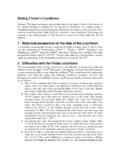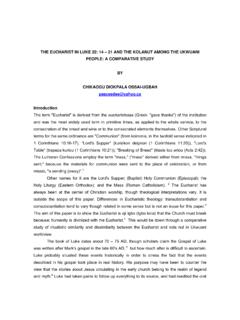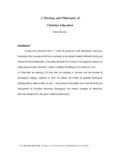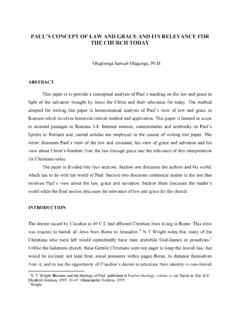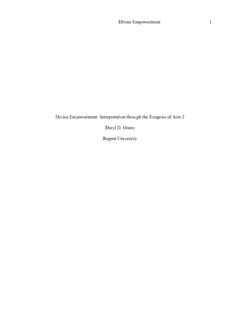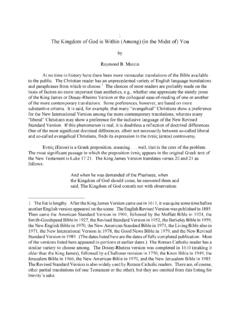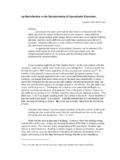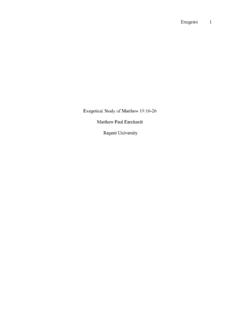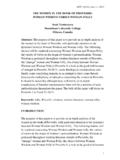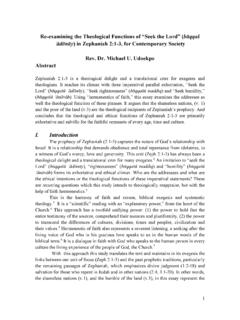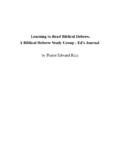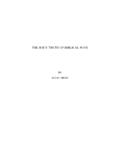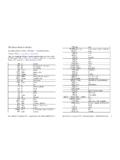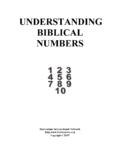Transcription of THE RELEVANCE OF HISTORICAL-CRITICAL METHOD OF …
1 THE RELEVANCE OF HISTORICAL-CRITICAL METHOD OF BIBLICAL INTERPRETATION FOR THE CHURCH IN AFRICA OLUGBENGA OLAGUNJU ; M. Th; Ph. D ABSTRACT The study of HISTORICAL-CRITICAL METHOD of biblical interpretation has been on-going for centuries. During its history, it has made major achievements and lasting contributions to the general field of Biblical studies. Today, HISTORICAL-CRITICAL studies have reached a climax whereby new development is being advocated by scholars from different theological Scholars are making frantic effort to make HISTORICAL-CRITICAL studies relevant in other fields of humanity. Attempts are being made to relate HISTORICAL-CRITICAL investigations to new researches in linguistics, literary criticism and social theory. historical -criticism is one of the several exegetical tools with which biblical interpreters utilize for biblical interpretation.
2 It should be considered indispensable tool for scholarly interpreters but should not be seen as a panacea for every exegetical hope and The interesting thing is that the proponents of these critical apparatus really want to know what the Biblical authors say and what they wrote. Their concern was not about the text per se but the history behind the text. 3 Thus, HISTORICAL-CRITICAL approaches discuss the world of the author vis a vis the culture, the language and the social background of the Biblical WHAT IS HISTORICAL-CRITICAL METHODS? A long period of time has elapsed since the writings that make up the Bible came into being. This great distance means that the culture of the people for whom these writings were intended originally was radically different from our own and this difference in culture involves a different world The HISTORICAL-CRITICAL studies are based on sound conviction that in order for one to understand the meaning of scripture for today, one must first understand its meaning for the original readers.
3 Some of the questions historical critics would ask include; of what literary form do we have the Old Testament:6 Are there different genres in the literary corpus, such as poetry, narrative, parables, apocalypse? Who wrote the book? In a situation where the authorship is hidden or disputed what are the options? What was the historical situation that surrounded the writing of a book? When did the author write? And what was the situation he was addressing? One of the greatest dangers in the process of biblical interpretation is that of taking a scriptural passage out of the context in which it was written. With this approach, the Bible can be used to support any ideology. To avoid this error, the question one can ask is, what was the central idea or thesis of this passage or what was the author saying or conveying? What was the place of this text in the book as a whole and what was its position in the immediate context?
4 What is the linguistic or grammatical context? Every modern biblical interpreter must always keep in mind that the Bible was written in a language different from his own. Therefore, there is the need to have a proper understanding of the language and the culture of the people so as to make the text relevant for the contemporary reader. As earlier said, biblical interpretation involves some understanding of the language in which it was written, that is Aramaic, hebrew and Greek. What were the stages by which they came into being, this concerns form criticism, the suggestion that many books that composed the Bible are composite, put together out of a number of originally separate Gerald Bray notes that the historical critical METHOD starts from the belief that any text or religious movement must be understood in its original context. 8 Oeming supporting Bray remarks that the goal of HISTORICAL-CRITICAL METHOD is the recovery of the original meaning each text had at the time when it was written.
5 9 The historical critics seeks to understand the intention of the author within its own world using tools common to academic disciplines outside of THE NATURE OF THE HISTORICAL-CRITICAL METHOD Barry Smith citing Semler in his four-volume work Abhandlung von freier Untersuchung des Canons (Treatise on the Free Investigation of the Canon), differentiates between the Word of God and the canon of the For him, canon does not denote a set of divinely inspired texts but merely collections of books chosen by churches as suitable for public reading. This disjunction allowed for the emergence of a new interpretive METHOD , which has become known as the HISTORICAL-CRITICAL Smith observes that if one follows Semler s view then the Bible would not be seen as a set of divinely inspired texts rather it would only be restricted to what the author intended it to mean and, therefore, its meaning would be tied to the author's historical Citing the words of Benjamin Jowett, Barton notes Scripture has one meaning the meaning which it had in the minds of the Prophet or Evangelist who first uttered or wrote to the hearers or readers who first received it.
6 14 Klein observed that the task of the HISTORICAL-CRITICAL scholar is to reconstruct the historical conditions of the production of a text and then to determine the author's intended meaning from within those parameters. 15 This is the historical side of the HISTORICAL-CRITICAL METHOD , what it means to understand a text historically. The HISTORICAL-CRITICAL METHOD , however, has another side: it is not only historical but also critical . Again, since the biblical texts are not to be considered as divinely inspired, it is obvious that the truth claims made by a biblical text be open to There can be no instances of special pleading; all texts are to be treated alike. In other words, the biblical texts are to have no a priori The HISTORICAL-CRITICAL METHOD is synonymous with the scientific approach to the study of the Bible as opposed to the "dogmatic" teaching of the The appellation scientific, of course, contains an implicit claim to superiority.
7 Smith commenting on the Semler s position on historical critical METHOD notes it is no coincidence that Semler is a rationalist in his theological Barry Smith thus sums up Semler s position as follows: The HISTORICAL-CRITICAL METHOD is the necessary methodological correlative of the rationalist assumption of human intellectual autonomy. Religion rationalistically conceived ("natural religion") is not dependent for its existence on a set of documents, divinely inspired or otherwise; the possibility of recognizing the truth of its maxims is intrinsic to the one who assents to these insofar as he or she possesses the faculty of reason. Rationalistic religious truth becomes, therefore, the criterion by which the contents of all "positive" religious texts, including the Bible, are determined to be authoritative for the reader. 20 This METHOD makes the Bible open to everyone to interpret whether one is a Christian or not in as much as one can reason historically.
8 So a non-Christian can adopt the HISTORICAL-CRITICAL METHOD when studying the Christian Bible. This is one of the strength of HISTORICAL-CRITICAL METHOD . However, some scholars like Moller, Hoyt and Smith were opposed to HISTORICAL-CRITICAL methods; though they did not condemn the METHOD out- right, they advocated for an improved METHOD that would benefit the church Karl Moller supports the view that HISTORICAL-CRITICAL methods cannot be done away with but can be improved. He developed two approaches on its improvement. First, he proposes historical approach which is the duty of the historical critics, where the culture and the background of the text is taken into consideration. Secondl, he offers the Christian approach, after the historical critic has fulfilled his duties; then he proceeds to interpretive process that would make meaning to his historical DEVELOPMENT OF BIBLICAL INTERPRETATION Broadly speaking, the emergence of historical critical studies for systematic interpretations of the Bible in the 1700s and their development in the 1800s fostered a sense of unity in biblical interpretations where the goal of interpreting the meaning of a text was perceived as arriving, through grammatical- historical methods, at some objective historical meaning of the text.
9 Biblical scholars and others alike who intended to apply readings of the Bible to contemporary issues of ecclesia and society would have had such a determinate meaning of a text as their starting point. However, two shifts occurred in succession which displaced historical criticism as the central METHOD , or at least disturbed its hegemony, in studying the Close reading (similar to formalism and New Criticism ) emerged in the 1920s and shifted the reading of texts from their social and historical context and from the interpreter s mind and life to the text itself. In interpreting a text what is important was the text itself, its structure, architecture, intrinsic form and the internal relationships of its A literary reading of texts was called for- this is the so called textual paradigm. Then in the 1960s, the textual paradigm was itself challenged by the emergence of post structural criticism, which shifted the controlling principle in reading texts from the text itself to the reader.
10 The reader mattered most since s/he was the one understood to confer meaning to a text ( the reader s paradigm ). Consequently, the field of Biblical Studies became methodologically plural and contested ground. 25 VARIOUS historical critical APPARATUS FOR STUDYING THE BIBLE The Bible is an historical book. It records the history of Israel and their neighbors in the words of humans who were inspired by Because the bible is an historical work which comprises ancient text, it is subject to historical investigation and the results of historical Thus, the overall purpose of HISTORICAL-CRITICAL METHOD is to investigate what actually happened in the events described in the text or what the author alluded to in the main context of the Krentz gives the following goals of historical investigation: Present a body of facts that show what actually happened and why.
